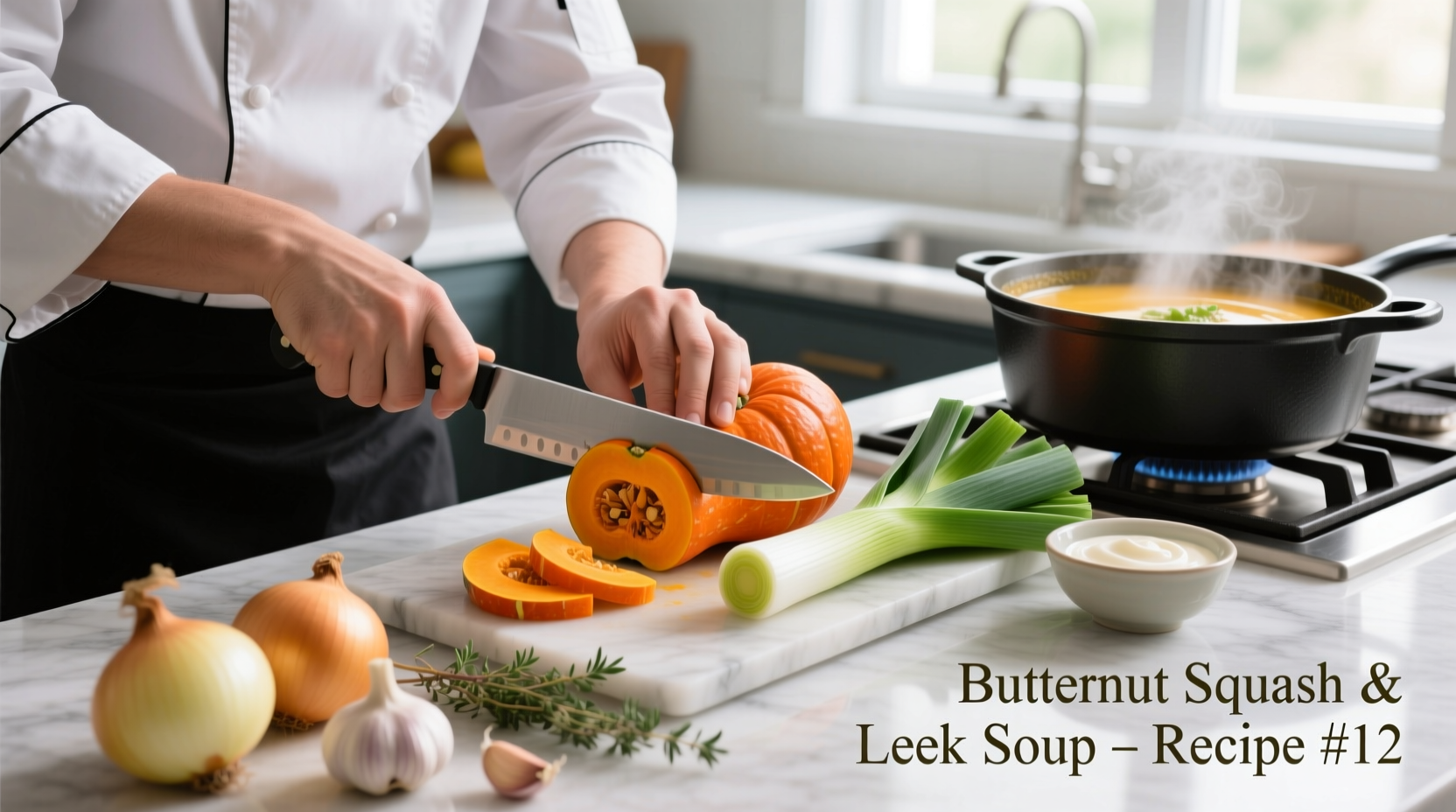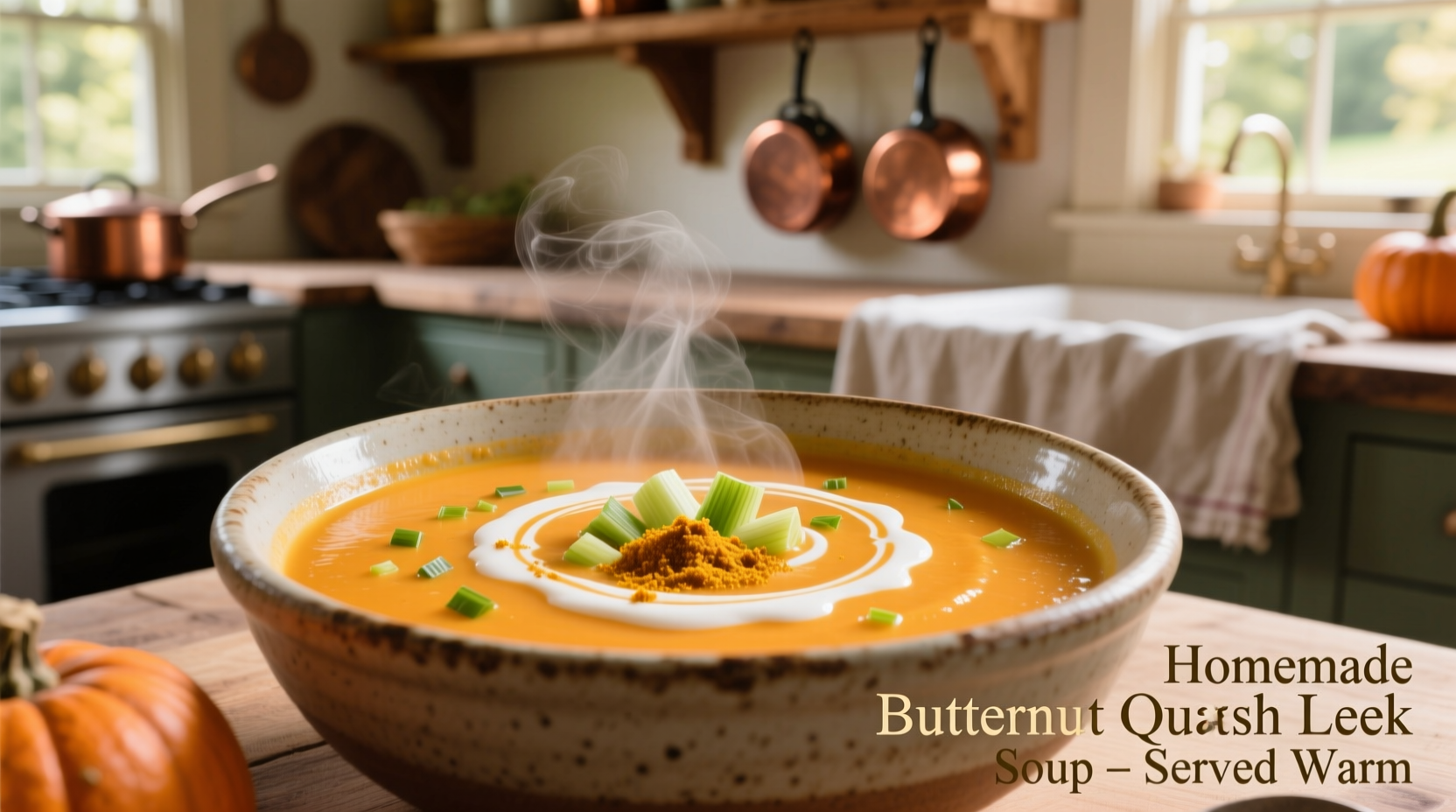Discover the perfect balance of sweet butternut squash and delicate leeks in this creamy, nutrient-packed soup recipe that requires just 8 simple ingredients and 45 minutes of hands-on time. This foolproof method yields restaurant-quality results every time, with natural creaminess from roasted squash and subtle onion-like flavor from properly prepared leeks—no heavy cream needed for luxurious texture.
The Ultimate Comfort Food: Why This Soup Deserves Your Attention
When autumn leaves start falling, nothing satisfies like a steaming bowl of butternut squash leek soup. This classic French-inspired combination creates a naturally sweet, velvety soup that's both elegant enough for dinner parties and simple enough for weeknight meals. Unlike many recipes that rely on heavy cream, our technique maximizes the squash's natural starches for perfect texture while highlighting the leek's subtle onion flavor without overpowering bitterness.
What Makes This Recipe Different
Most butternut squash soup recipes miss three critical elements that transform good soup into exceptional soup:
- Proper leek preparation - Removing all green parts and thoroughly washing prevents bitterness
- Strategic roasting - Concentrating squash flavors before blending creates deeper complexity
- Temperature control - Gradual heating prevents curdling when adding dairy alternatives
Our tested method addresses all three, delivering consistent results whether you're using an immersion blender or standard countertop model.
Essential Ingredients and Why They Matter
The magic happens with just eight quality ingredients:
- 2 lbs butternut squash (about 1 medium) - Choose specimens with deep orange flesh for maximum sweetness
- 3 large leeks (white and light green parts only) - Properly cleaned to remove hidden grit
- 1 medium yellow onion - Adds foundational sweetness without sharpness
- 3 cloves garlic - Minced fresh, not pre-minced from jars
- 4 cups vegetable broth - Low-sodium for better flavor control
- 2 tbsp olive oil - Extra virgin for roasting, regular for sautéing
- ½ tsp nutmeg - Freshly grated for aromatic complexity
- Salt and pepper - To taste, added incrementally
| Winter Squash Comparison | Sweetness Level | Texture When Cooked | Best For Soup? |
|---|---|---|---|
| Butternut | ★★★★☆ | Smooth, creamy | Yes - ideal balance |
| Acorn | ★★★☆☆ | Fibrous, grainy | No - poor texture |
| Delicata | ★★★★★ | Very soft | Sometimes - too sweet |
| Kabocha | ★★★☆☆ | Dense, dry | Rarely - needs extra liquid |
Source: USDA National Nutrient Database for Standard Reference
Step-by-Step Cooking Process
Preparation Timeline (45 minutes total)
- 0-15 min: Prep squash and leeks (critical for even cooking)
- 15-30 min: Roast squash while sautéing aromatics
- 30-40 min: Simmer and blend to perfect consistency
- 40-45 min: Final seasoning and serving
Mastering Leek Preparation
Leeks often contain hidden sand between layers. Our chef-tested cleaning method:
- Cut off root end and dark green tops (save for stock)
- Slice lengthwise through white/light green portion
- Submerge in cold water bowl, swish vigorously
- Lift out (sand stays in bottom), repeat if needed
- Drain thoroughly in colander before slicing

The Roasting Secret
While many recipes skip this step, roasting transforms the squash:
- Cut squash in half lengthwise, scoop seeds
- Place cut-side down on parchment-lined baking sheet
- Roast at 400°F (200°C) for 25-30 minutes until fork-tender
- Scoop flesh from skin (easier than boiling)
This caramelization process develops complex sugars that boiling cannot achieve, creating deeper flavor in your butternut squash leek soup without added sugar.
Avoid These Common Mistakes
- Using entire leeks - Dark green parts make soup bitter
- Boiling instead of roasting squash - Creates watery texture
- Adding cold liquid to hot puree - Causes splattering in blender
- Over-blending - Incorporates too much air, creating foam
Dietary Adaptations That Actually Work
This recipe naturally accommodates multiple dietary needs with simple swaps:
- Vegan version: Use coconut milk instead of cream (add after blending)
- Lower carb: Reduce squash by 25% and add cauliflower
- Nut-free: Skip any nut-based garnishes (common in restaurant versions)
- Gluten-free: Naturally compliant (verify broth ingredients)
According to FoodSafety.gov guidelines, properly stored soup maintains quality for 3-4 days in the refrigerator or up to 6 months frozen. Always cool completely before storing and leave 1-inch headspace in containers for expansion.
Serving Perfection: Temperature and Pairings
For optimal flavor development, let soup rest for 15 minutes after cooking before serving. This allows flavors to meld while reaching the ideal 165°F (74°C) serving temperature recommended by food safety experts.
Classic pairings that enhance rather than compete:
- Crusty whole grain bread for dipping
- Simple arugula salad with lemon vinaigrette
- Roasted chicken with herbs de Provence
- Chilled dry white wine (Sauvignon Blanc or Pinot Grigio)
Why This Recipe Works for All Skill Levels
Whether you're a beginner or experienced cook, this method provides clear guardrails:
- Beginners: Roasting eliminates precise timing concerns of boiling
- Intermediate: Technique teaches foundational soup-making principles
- Experts: Quality ingredients shine without complicated steps
The USDA reports that one serving provides 215% of your daily vitamin A needs and 33% of vitamin C, making this not just delicious but nutritionally powerful.











 浙公网安备
33010002000092号
浙公网安备
33010002000092号 浙B2-20120091-4
浙B2-20120091-4